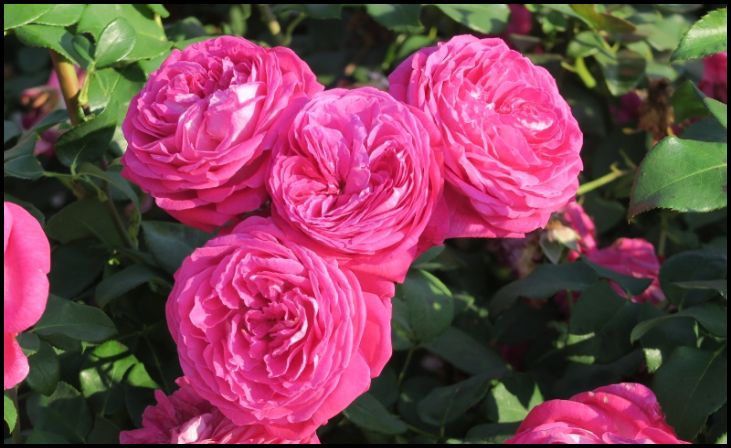Roses are often considered the epitome of garden beauty. Their diverse range of colors, forms, and fragrances can enhance any garden space. However, choosing the right type of rose for your garden can make all the difference. Let’s explore the best types of roses for every garden and how to care for them.
Floribunda
Floribundas are a delightful addition to any garden. First created around 1940, these hybrids combine the vibrant color range of hybrid teas with the free-flowering nature of polyanthas. They produce clusters of blooms that create a stunning visual impact. Floribundas thrive in well-drained soil with plenty of sunlight. Regular feeding and deadheading encourage continuous blooming. These roses are ideal for borders and beds, offering a prolific display of color throughout the growing season.
Hybrid Tea

Hybrid teas, introduced in 1867, are known for their elegant, single blooms on long stems, making them perfect for cutting and arrangements. They are a mix between tea roses and hybrid perpetuals and are considered the first modern rose variety. To care for hybrid teas, plant them in a location with full sun and well-drained soil. Regular pruning helps maintain their shape and encourages larger blooms. They require consistent watering and feeding to flourish.
Grandiflora
Grandifloras are a cross between floribundas and hybrid teas, first introduced in the 1950s. These larger shrub varieties combine the best traits of both parents, producing large, showy blooms on robust bushes. These roses prefer sunny locations and rich, well-drained soil. They benefit from regular pruning to maintain their structure and vigor. Grandifloras make excellent focal points in gardens due to their impressive size and bloom production.
Polyantha

Polyanthas, created in the late 1800s, resemble smaller floribundas with dense growth habits and clusters of 1- to 2-inch blooms. They are incredibly resilient and produce an abundance of flowers throughout the season. Polyanthas thrive in a variety of soil types, provided they are well-drained. They are low-maintenance and highly resistant to disease, making them ideal for novice gardeners. These roses are perfect for borders and low hedges.
Shrub Roses
Shrub roses are versatile and hardy, making them a great alternative to more delicate hybrid teas. This category includes varieties like English roses, Kordesii, and hybrid musk. They are known for their robust growth and disease resistance. Shrub roses can be planted in almost any garden setting. They require minimal pruning and are highly adaptable to different soil conditions. These roses are excellent for creating informal hedges and mixed borders.
Climbing Roses
Climbing roses are ideal for adding vertical interest to your garden. They can be trained to grow around fences, pergolas, and arbors, creating a stunning display of blooms. Climbing roses offer a range of colors and bloom sizes. To grow climbers successfully, provide them with a sturdy structure to support their growth. They need plenty of sunlight and well-drained soil. Regular training and tying ensure they grow in the desired direction.
Miniature Roses

Despite their name, some miniature roses can grow as large as floribundas. Bred for their compact size and tiny one-inch blooms, they are perfect for container gardening and small spaces. Miniature roses require the same care as their larger counterparts, with a focus on regular watering, feeding, and pruning to keep them healthy and vibrant.
English (David Austin) Roses
English roses, developed by David Austin, are beloved for their old-world charm and delightful fragrance. These roses combine the best qualities of old garden roses with the repeat flowering of modern varieties. English roses are known for their large, cupped blooms and wide range of colors. They thrive in well-drained soil with ample sunlight and benefit from regular feeding and pruning to maintain their shape and health.
Choosing the Right Rose for Your Garden
When selecting roses for your garden, consider factors such as climate, space, and desired aesthetics. Match the rose type to your garden’s conditions to ensure the best growth and bloom performance. For example, if you have limited space, miniature or shrub roses may be ideal. For vertical accents, climbing roses are a great choice.
Planting and Caring for Roses

Planting roses involves choosing a sunny location with well-drained soil. Dig a hole large enough to accommodate the root ball, and mix in compost to enrich the soil. Water the newly planted rose thoroughly and mulch around the base to retain moisture. Regular watering, feeding with a balanced fertilizer, and pruning are essential for healthy growth and abundant blooms.
Dealing with Pests and Diseases
Roses can be susceptible to pests and diseases such as aphids, black spot, and powdery mildew. Regular inspection and proper maintenance can help prevent these issues. Use organic or chemical treatments as needed, and ensure good air circulation around the plants to reduce disease risk.
Seasonal Rose Care

Caring for roses varies with the seasons. In spring, prune to shape and remove dead wood. Summer care involves regular watering and feeding. In fall, reduce watering and prepare the plants for winter by adding mulch. Winter protection may include covering roses with burlap or providing additional mulch to insulate the roots.
Creating Beautiful Rose Arrangements
Cutting and arranging roses can bring garden beauty indoors. Cut roses early in the morning when they are freshest, and place them in water immediately. Use a clean vase and change the water regularly to extend the life of the arrangement. Mixing different rose varieties can create stunning displays.




